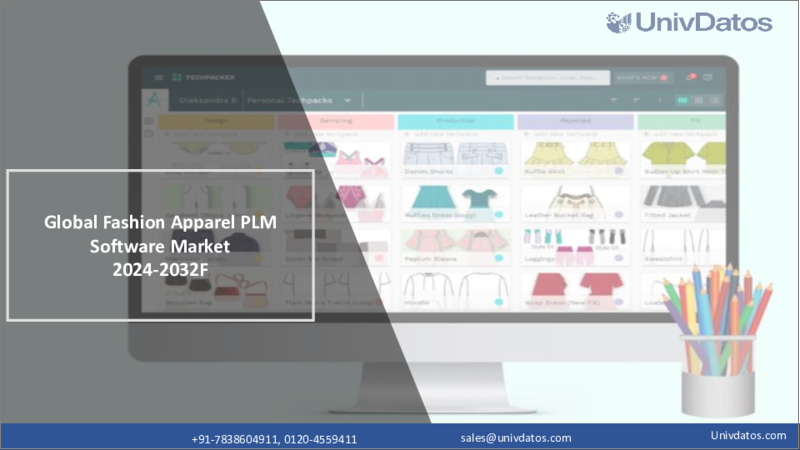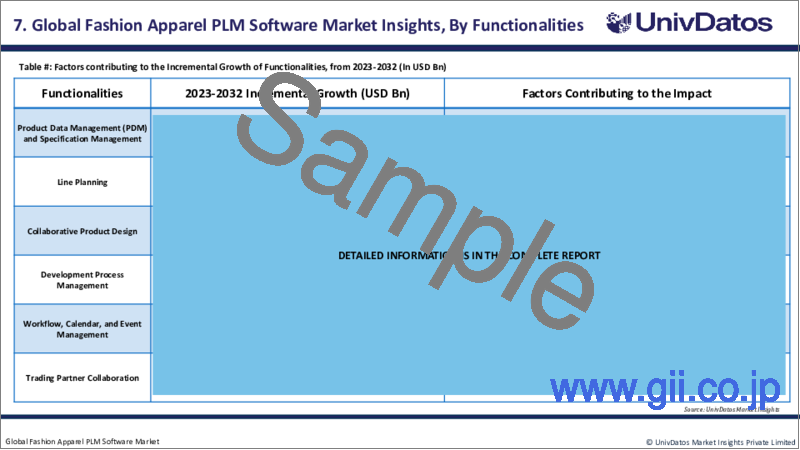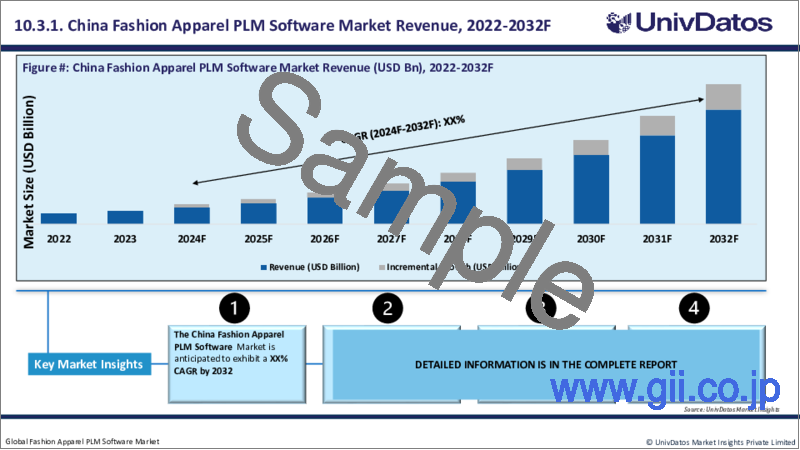|
|
市場調査レポート
商品コード
1461360
ファッションアパレルPLMソフトウェア市場:現状分析と予測(2023-2030年)Fashion Apparel PLM Software Market: Current Analysis and Forecast (2023-2030) |
||||||
カスタマイズ可能
|
|||||||
| ファッションアパレルPLMソフトウェア市場:現状分析と予測(2023-2030年) |
|
出版日: 2024年03月01日
発行: UnivDatos Market Insights Pvt Ltd
ページ情報: 英文 142 Pages
納期: 即日から翌営業日
|
全表示
- 概要
- 目次
ファッションアパレルPLMソフトウェア市場は、世界市場におけるファッション・アパレル製品の需要急増により、CAGR約12.08%の高成長が見込まれています。ファッション・アパレル製品の需要増加の背景には、eコマースの台頭があります。オンライン・ショッピングの利便性により、消費者は今や世界中の膨大なファッション・オプションに指先ひとつでアクセスできるようになった。さらに、ソーシャル・メディア・プラットフォームも、ファッション・アパレル製品の需要を煽る上で重要な役割を果たしています。インフルエンサーやセレブリティが定期的に流行の服装やスタイルをフォロワーに紹介することで、消費者の関心を高め、購買決定に影響を与えています。例えば、Bazaarvoiceの調査によると、消費者の70%はソーシャルメディアの推薦に基づいて購入する可能性が高く、ソーシャルメディアがファッション消費に与える影響の大きさが浮き彫りになっています。さらに、ファッション・アパレル製品への需要の高まりは、市場におけるファッション・アパレル製品ライフサイクル管理(PLM)ソフトウェアへの関心の高まりにも拍車をかけています。PLMソフトウェアは、ファッション企業が製品開拓プロセスを合理化し、サプライチェーンを効率的に管理し、新製品の市場投入までの時間を短縮するのに役立ちます。企業は進化し続けるファッション業界の需要に応えようと努力しており、PLMソフトウェアの導入は競争力を維持するために不可欠となっています。
機能性に基づいて、市場は製品データ管理と仕様管理、ライン・プランニング、コラボレーティブ製品設計、開発プロセス管理、ワークフロー、カレンダー、イベント管理、取引先コラボレーションに分類されます。PLMソフトウェアの需要を最大化する中核機能のひとつは、製品データ管理と仕様管理です。この機能により、ファッションブランドは、デザイン仕様、素材、価格など、すべての製品関連情報を一元管理することができます。製品データの真実の単一ソースを提供することで、企業はエラーを減らし、精度を向上させ、製品ライフサイクル全体を通して意思決定プロセスを強化することができます。さらに、ライン・プランニングもまた、ファッションアパレルPLMソフトウェア分野で大きな市場シェアを占める重要な要素です。ファッションアパレルPLMソフトウェアセグメントにおけるこれらの中核機能の市場支配力には、いくつかの要因が寄与しています。例えば、ファッション業界におけるサプライチェーンの複雑化と世界化に伴い、膨大な量のデータを管理し、プロセスを合理化し、地域間のコラボレーションを促進できる堅牢なソリューションが必要とされており、世界市場におけるファッションアパレルPLMソフトウェアの需要拡大に極めて重要な役割を果たしています。
用途別に見ると、市場は売上成長、マージン拡大、運転資本削減、市場投入時間短縮、生産性向上、在庫回転率向上に区分されます。市場投入時間の短縮は、ファッションアパレル業界のビジネスにとって重要な要素です。ファッション業界は競争が激しく、動向がめまぐるしく変化し、消費者の嗜好も常に進化しているからです。その結果、企業は時代の最先端を行くために、迅速かつ効率的な技術革新を行う必要があります。さらに、ファッション業界は季節ごとに新しいコレクションを発表します。消費者に適切なタイミングで商品を届けるためには、迅速な納期が欠かせないです。さらに、市場投入までの時間を短縮することは、生産リードタイムを短縮し、在庫保有コストを最小限に抑え、季節外れの商品のマークダウンを回避することで、企業のコスト削減につながります。ファッション・アパレル業界の企業は、PLMソフトウェアを活用することで、デザイン、開発、生産のプロセスを合理化し、新製品をより迅速かつ効率的に市場に投入することができます。PLMソフトウェアは、製品データの管理、コラボレーション、ワークフローの自動化のための一元化されたプラットフォームを提供し、企業がエラーを減らし、コミュニケーションを改善し、市場投入までの時間を短縮するのに役立ちます。
市場は、アプリケーションの段階に基づき、設計、開発、プリプロダクション、資材管理、調達・生産、品質保証、流通・ロジスティクス、販売・マーケティング、オーナー・エクスペリエンス、シーズンラインプランニングに区分されます。品質保証は、ファッション・アパレル業界において最も重要な段階のひとつです。品質保証は、製品が顧客の手元に届く前に望ましい品質基準を満たしていることを保証し、それによってブランドの評判と顧客満足度を高める。このプロセスにおいて、ファッション・アパレル製品ライフサイクル管理(PLM)ソフトウェアは、業務の合理化、コミュニケーションの改善、製品品質の向上において極めて重要な役割を果たします。さらに、ファッション・アパレル業界における品質保証の段階でも、PLMソフトウェアの導入は大きなメリットをもたらします。業務の合理化、コミュニケーションの強化、ワークフローの自動化、トレーサビリティの確保、リスク管理、コンプライアンスの維持、パフォーマンスの監視など、PLMは製品の品質と顧客満足度を確保するために不可欠なツールとなっています。堅牢なPLMソフトウェアに投資するファッション・アパレル企業は、競争が激化し、品質が重視される市場の需要に対応するためのより良い設備を備えています。
市場に関する理解を深めるため、市場は北米(米国、カナダ、その他北米地域)、欧州(ドイツ、英国、フランス、スペイン、イタリア、その他欧州地域)、アジア太平洋地域(中国、日本、インド、その他アジア太平洋地域)、世界のその他の地域における世界のプレゼンスに基づいて分析されています。アジア太平洋地域は、予測される期間内に大幅な成長を遂げると予想されています。アジア太平洋地域が衣料品・アパレル製造業で優位に立つ主な要因の1つは、費用対効果の高い労働力です。中国、バングラデシュ、ベトナム、インドのような国々は、競争力のある人件費を提供しており、企業にとってより手頃な価格で生産を行うことができます。さらに、この地域の急速な都市化によって、可処分所得の高い中間層が急増しています。このような人口動態の変化が、流行の衣料品やアパレル・アイテムの需要に拍車をかけ、業界の成長を牽引しています。さらに、製造施設と熟練労働者の広大なネットワークにより、アジア太平洋地域は世界最大の衣料品・アパレル製品の輸出国となっています。中国、バングラデシュ、ベトナムは、この地域のトップ輸出国のひとつです。アジア太平洋地域が衣料品・アパレル製品の最大の製造・輸出・消費地としての地位を固めるにつれ、ファッション・アパレル製品ライフサイクル管理(PLM)ソフトウェアの需要が大幅に急増しています。PLMソフトウェアは、ファッション業界における設計、生産、流通のプロセスを合理化し、企業が効率性を高めて市場競争力を維持するのに役立っています。
目次
第1章 市場イントロダクション
- 市場の定義
- 主な目標
- ステークホルダー
- 制限事項
第2章 調査手法または前提条件
- 調査プロセス
- 調査手法
- 回答者プロファイル
第3章 市場要約
第4章 エグゼクティブサマリー
第5章 COVID-19がファッションアパレルPLMソフトウェア市場に与える影響
第6章 ファッションアパレルPLMソフトウェア市場収益、2020-2030年
第7章 機能別の市場分析
- 製品データ管理(PDM)と仕様管理
- ライン計画
- 共同製品デザイン
- 開発プロセス管理
- ワークフロー、カレンダー、イベント管理
- 取引先とのコラボレーション
第8章 アプリケーション別の市場分析
- 売上高の伸び
- マージン拡大
- 運転資本の削減
- 市場投入までの時間の短縮
- 生産性の向上
- 在庫回転率の向上
第9章 応用段階別の市場分析
- デザイン
- 開発と試作
- 資材管理
- 調達と生産
- 品質保証
- 流通・物流
- セールスとマーケティング
- オーナーの経験
- 季節とライン計画
第10章 地域別市場分析
- 北米
- 米国
- カナダ
- その他北米地域
- 欧州
- ドイツ
- 英国
- フランス
- イタリア
- その他欧州地域
- アジア太平洋
- 中国
- インド
- 日本
- 韓国
- その他アジア太平洋地域
- 世界のその他の地域
第11章 ファッションアパレルPLMソフトウェア市場力学
- 市場促進要因
- 市場の課題
- 影響分析
第12章 ファッションアパレルPLMソフトウェア市場機会
第13章 ファッションアパレルPLMソフトウェア市場動向
第14章 需要と供給の分析
- 需要側分析
- 供給側分析
第15章 バリューチェーン分析
第16章 競争シナリオ
- 競合情勢
- ポーターのファイブフォース分析
第17章 会社概要
- Adobe
- Autometrix Precision Cutting Systems, Inc.
- Siemens
- Corel Corporation
- Autodesk Inc.
- CGS
- TUKATECH
- VetiGraph
- C-DESIGN Fashion
- K3
第18章 免責事項
Fashion apparel PLM software, also known as Product Lifecycle Management software, is a specialized technology solution designed for the fashion industry to streamline and manage the entire product development process from conceptualization to production. This software enables fashion companies to centralize and organize critical product information, including design sketches, technical specifications, materials, and supplier data, in one centralized system. Furthermore, Fashion apparel PLM software facilitates collaboration across different departments within a fashion company, including design, merchandising, sourcing, production, and quality control, by providing a centralized platform for communication and decision-making. It helps in tracking the progress of each product, managing timelines, and ensuring that all stakeholders are aligned on the product development cycle.
The Fashion Apparel PLM Software Market is expected to grow at a strong CAGR of around 12.08 % owing to the booming demand for fashion and apparel products in the global markets. One of the primary drivers behind the increasing demand for fashion and apparel products is the rise of e-commerce. With the convenience of online shopping, consumers now have access to a vast array of fashion options from around the world at their fingertips. Furthermore, social media platforms have also played a crucial role in fueling the demand for fashion and apparel products. Influencers and celebrities regularly showcase trendy outfits and styles to their followers, driving consumer interest and influencing purchasing decisions. For instance, according to a study by Bazaarvoice, 70% of consumers are more likely to make a purchase based on social media recommendations, highlighting the significant impact of social media on fashion consumption. Moreover, the growing demand for fashion and apparel products has also spurred an increased interest in fashion apparel Product Lifecycle Management (PLM) software in the markets. PLM software helps fashion companies streamline their product development processes, manage supply chains efficiently, and reduce time-to-market for new products. As companies strive to meet the demands of an ever-evolving fashion industry, the adoption of PLM software has become crucial for staying competitive.
Based on functionalities, the market is categorized into product data management and specification management, line planning, collaborative product design, development process management, workflow, calendar, and event management, and trading partner collaboration. One of the core functionalities that generates maximum demand for PLM software is Product Data Management and Specification Management. This feature enables fashion brands to centralize and manage all product-related information, including design specifications, materials, and pricing. By providing a single source of truth for product data, companies can reduce errors, improve accuracy, and enhance decision-making processes throughout the product lifecycle. Furthermore, Line Planning is another critical aspect that holds a significant market share within the fashion apparel PLM software segment. Several factors contribute to the market domination of these core functionalities within the fashion apparel PLM software segment. For instance, the increasing complexity and globalization of supply chains in the fashion industry necessitate robust solutions that can manage vast amounts of data, streamline processes, and foster collaboration across geographies, and are playing a pivotal role in fueling the growth in demand for the fashion apparel PLM software in the global markets.
Based on application, the market is segmented into sales growth, margin expansion, reduction in working capital, reduction in time to market, productivity boost, and increased inventory turnover. The reduction in time to market application stands out as a critical factor for businesses in the fashion apparel industry. This is because the fashion industry is highly competitive, with trends changing rapidly and consumer preferences evolving constantly. As a result, companies need to innovate quickly and efficiently to stay ahead of the curve. Furthermore, the fashion industry operates on a seasonal basis, with companies releasing new collections multiple times a year. Quick turnaround times are crucial to ensure that products are available to consumers at the right time. Moreover, faster time to market can lead to cost savings for companies by reducing production lead times, minimizing inventory holding costs, and avoiding markdowns on out-of-season merchandise. By leveraging PLM software, businesses in the fashion apparel industry can streamline their design, development, and production processes, enabling them to bring new products to market more quickly and efficiently. PLM software provides a centralized platform for managing product data, collaboration, and workflow automation, helping companies reduce errors, improve communication, and accelerate time to market.
Based on stages of application, the market is segmented into design, development and preproduction, material management, sourcing and production, quality assurance, distribution and logistics, sales and marketing, owners experience, and seasonal and line planning. Quality assurance is one of the most critical stages in the fashion and apparel industry. It ensures that the products meet the desired standards of quality before they reach the customers, thereby enhancing brand reputation and customer satisfaction. In this process, the fashion and apparel Product Lifecycle Management (PLM) software plays a pivotal role in streamlining operations, improving communication, and enhancing product quality. Furthermore, the quality assurance stage in the fashion and apparel industry benefits greatly from the implementation of PLM software. Its ability to streamline operations, enhance communication, automate workflows, ensure traceability, manage risks, maintain compliance, and monitor performance makes it an indispensable tool for ensuring product quality and customer satisfaction. Fashion and apparel companies that invest in robust PLM software are better equipped to meet the demands of an increasingly competitive and quality-conscious market.
For a better understanding, the market is analyzed based on its worldwide presence in countries such as North America (The U.S., Canada, and the Rest of North America), Europe (Germany, The U.K., France, Spain, Italy, Rest of Europe), Asia-Pacific (China, Japan, India, Rest of Asia-Pacific), Rest of World. The Asia Pacific is expected to experience substantial growth in the predicted timeframe. One of the key factors driving Asia Pacific's dominance in clothing and apparel manufacturing is its cost-effective labor force. Countries like China, Bangladesh, Vietnam, and India offer competitive labor costs, making production more affordable for companies. Furthermore, The region's rapid urbanization has created a burgeoning middle-class population with higher disposable incomes. This demographic shift has fueled the demand for trendy clothing and apparel items, driving the growth of the industry. Moreover, with a vast network of manufacturing facilities and skilled labor, Asia Pacific has become the largest exporter of clothing and apparel products worldwide. China, Bangladesh, and Vietnam are among the top exporters in the region. As Asia Pacific solidifies its position as the biggest manufacturer, exporter, and consumer of clothing and apparel products, the demand for Fashion Apparel Product Lifecycle Management (PLM) software has witnessed a significant surge. PLM software streamlines the design, production, and distribution processes in the fashion industry, helping companies enhance efficiency and stay competitive in the market.
Some of the major players operating in the market include Adobe; Autometrix Precision Cutting Systems, Inc.; Siemens; Corel Corporation; Autodesk Inc.; CGS; TUKATECH; VetiGraph; C-DESIGN Fashion; and K3
TABLE OF CONTENTS
1.MARKET INTRODUCTION
- 1.1.Market Definitions
- 1.2.Main Objective
- 1.3.Stakeholders
- 1.4.Limitation
2.RESEARCH METHODOLOGY OR ASSUMPTION
- 2.1.Research Process of the Fashion Apparel PLM Software Market
- 2.2.Research Methodology of the Fashion Apparel PLM Software Market
- 2.3.Respondent Profile
3.MARKET SYNOPSIS
4.EXECUTIVE SUMMARY
5.IMPACT OF COVID-19 ON THE FASHION APPAREL PLM SOFTWARE MARKET
6.FASHION APPAREL PLM SOFTWARE MARKET REVENUE (USD BN), 2020-2030F.
7.MARKET INSIGHTS BY FUNCTIONALITIES
- 7.1.Product Data Management (PDM) and Specification Management
- 7.2.Line Planning
- 7.3.Collaborative Product Design
- 7.4.Development Process Management
- 7.5.Workflow, Calendar, and Event Management
- 7.6.Trading Partner Collaboration
8.MARKET INSIGHTS BY APPLICATION
- 8.1.Sales Growth
- 8.2.Margin Expansion
- 8.3.Reduction in Working Capital
- 8.4.Reduction in Time to Market
- 8.5.Productivity Boost
- 8.6.Increased Inventory Turnover
9.MARKET INSIGHTS BY STAGES OF APPLICATION
- 9.1.Design
- 9.2.Development and Preproduction
- 9.3.Material Management
- 9.4.Sourcing and Production
- 9.5.Quality Assurance
- 9.6.Distribution and Logistics
- 9.7.Sales and Marketing
- 9.8.Owners Experience
- 9.9.Seasonal and Line Planning
10.MARKET INSIGHTS BY REGION
- 10.1.North America
- 10.1.1.The U.S.
- 10.1.2.Canada
- 10.1.3.Rest of North America
- 10.2.Europe
- 10.2.1.Germany
- 10.2.2.The U.K.
- 10.2.3.France
- 10.2.4.Italy
- 10.2.5.Rest of Europe
- 10.3.Asia-Pacific
- 10.3.1.China
- 10.3.2.India
- 10.3.3.Japan
- 10.3.4.South Korea
- 10.3.5.Rest of Asia-Pacific
- 10.4.Rest of the World
11.FASHION APPAREL PLM SOFTWARE MARKET DYNAMICS
- 11.1.Market Drivers
- 11.2.Market Challenges
- 11.3.Impact Analysis
12.FASHION APPAREL PLM SOFTWARE MARKET OPPORTUNITIES
13.FASHION APPAREL PLM SOFTWARE MARKET TRENDS
14.DEMAND AND SUPPLY-SIDE ANALYSIS
- 14.1.Demand Side Analysis
- 14.2.Supply Side Analysis
15.VALUE CHAIN ANALYSIS
16.COMPETITIVE SCENARIO
- 16.1.Competitive Landscape
- 16.1.1.Porters Fiver Forces Analysis
17.COMPANY PROFILED
- 17.1.Adobe
- 17.2.Autometrix Precision Cutting Systems, Inc.
- 17.3.Siemens
- 17.4.Corel Corporation
- 17.5.Autodesk Inc.
- 17.6.CGS
- 17.7.TUKATECH
- 17.8.VetiGraph
- 17.9.C-DESIGN Fashion
- 17.10.K3






